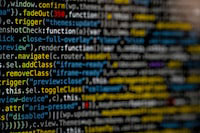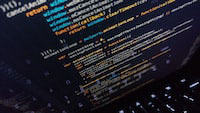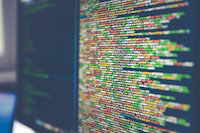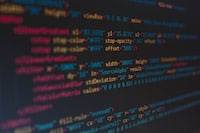 Backend Development
Backend Development Python Tutorial
Python Tutorial Navigating the Ocean of Data: Getting Started with Python Data Analysis
Navigating the Ocean of Data: Getting Started with Python Data Analysis
Data analysis has become an integral part of the modern business world. Extracting valuable insights from massive data sets is easier than ever with powerful tools like python. This guide will serve as a map for your journey into Python data analysis, guiding you from the basics to advanced concepts.
Basic knowledge
- Python language basics: Variables, data types, operators and control flow structures
- Data structures: List, Tuple, Dictionary and NumPy Array
- Data cleaning and preprocessing: Handling missing values, outliers and data type conversion
- Data Visualization: Create charts and graphs using Matplotlib and Seaborn
Data Exploration and Analysis
- Statistical analysis:Compute descriptive statistics, distributions and hypothesis testing
- Time Series Analysis: Processing time series data, identifying patterns and forecasting
- Machine learning basics: Supervised and unsupervisedThe concept of learning, and model evaluation
Data Modeling and Forecasting
- Regression analysis: Construct linear regression and logistic regression models
- Decision Trees and Random Forests: Creating Complex Nonlinear Models
- Time Series Forecasting: Forecasting using ARIMA and SARIMA models
- Neural Networks: UnderstandingNeural NetworksArchitecture, Training and Evaluation
Advanced Technology
- Big data analysis: Use spark and hadoop to process big dataset
- Natural language processing: Processing text data, extracting text features and performing sentiment analysis
- Optimization of machine learning algorithms: Understand hyperparameter tuning, regularization and cross-validation
- Cloud computing: Use cloud platforms such as AWS, Azure or Google Cloud for data analysis
Best Practices and Tips
- Use an integrated development environment (IDE): Choose a feature-rich IDE such as PyCharm or Jupyter Notebook
- Get familiar with data analysis libraries: Take advantage of the power of pandas, Scikit-learn, Seaborn and other libraries
- Practice is key: Improve your skills by solving real problems and building projects
- Find community support: Join data analysis forums and communities to find help and insights from experienced professionals
- Keep learning: Keep updating your knowledge and skills as technology advances
in conclusion
Embarking on the journey of Python data analysis requires a comprehensive foundation, continuous exploration and continuous learning. By following this guide, you'll acquire the skills and tools necessary to extract valuable insights from the ocean of data to make informed decisions for your business. Remember, data analysis is an ongoing adventure filled with opportunities and challenges. By embracing curiosity and continually refining your craft, you'll become a skilled data analyst who succeeds in today's data-driven world.The above is the detailed content of Navigating the Ocean of Data: Getting Started with Python Data Analysis. For more information, please follow other related articles on the PHP Chinese website!
 解密 PHP SOAP 的神秘世界:揭开其内部运作机制Mar 18, 2024 am 08:00 AM
解密 PHP SOAP 的神秘世界:揭开其内部运作机制Mar 18, 2024 am 08:00 AMPHPSOAP(简单对象访问协议)是一个php扩展,允许开发人员通过Http协议构建和使用WEB服务。它提供了与远程SOAP服务器交互的工具,从而简化了不同系统之间的通信。了解SOAP的内部运作机制对于有效利用其功能至关重要。SOAP消息结构SOAP消息遵循严格的XML格式。它们由一个Envelope元素组成,其中包含一个Header元素(可选)和一个Body元素。Header元素包含消息的元数据,而Body元素包含实际请求或响应。消息流PHPSOAP使用SOAPClient类与SOAP服务器进
 Python在区块链智能合约中的关键作用Mar 16, 2024 pm 11:50 PM
Python在区块链智能合约中的关键作用Mar 16, 2024 pm 11:50 PMpython因其清晰简洁的语法、丰富的库和广泛的开发者社区而在区块链领域备受推崇。它被广泛用于开发智能合约,这是在区块链上执行的自动执行协议。智能合约开发Python提供了许多工具和库,使智能合约的开发变得简单高效。这些工具包括:Web3.py:一个与以太坊区块链交互的库,使开发人员能够轻松部署、调用和管理智能合约。Vyper:一种与Python语法类似的智能合约编程语言,简化了智能合约的编写和审计。Truffle:一个用于智能合约开发、测试和部署的框架,提供了丰富的工具和自动化支持。测试和安全
 Java JSP 安全漏洞:防护您的 Web 应用程序Mar 18, 2024 am 10:04 AM
Java JSP 安全漏洞:防护您的 Web 应用程序Mar 18, 2024 am 10:04 AMJavaServerPages(jsP)是一种Java技术,用于创建动态的WEB应用程序。JSP脚本在服务器端执行,并在客户端渲染为html。然而,JSP应用程序容易受到各种安全漏洞的影响,这些漏洞可能导致数据泄露、代码执行或拒绝服务。常见安全漏洞1.跨站点脚本(XSS)XSS漏洞允许攻击者将恶意脚本注入Web应用程序,这些脚本将在受害者访问页面时执行。攻击者可以使用这些脚本窃取敏感信息(如cookie和会话ID)、重定向用户或破坏页面。2.注入漏洞注入漏洞允许攻击者向Web应用程序的数据库查询
 Python 和 Jython:解锁跨平台开发的潜力Mar 18, 2024 pm 10:20 PM
Python 和 Jython:解锁跨平台开发的潜力Mar 18, 2024 pm 10:20 PM跨平台开发对于构建可同时在多种操作系统上无缝运行的应用程序至关重要。python和Jython作为领先的编程语言,提供跨平台开发的强大解决方案,释放其潜力。Python的跨平台兼容性Python是一种解释型语言,它使用虚拟机来执行代码。这种架构允许Python代码在多种平台上运行,包括windows、linux、MacOS和移动设备。Python的广泛平台支持使其成为构建跨平台应用程序的理想选择。此外,Python拥有丰富的第三方库生态系统,提供广泛的功能,从数据处理和WEB开发到机器学习和数据
 PHP 表单处理的革命:改变网站交互方式Mar 17, 2024 pm 04:01 PM
PHP 表单处理的革命:改变网站交互方式Mar 17, 2024 pm 04:01 PMPHP表单处理一直是网站开发中不可或缺的一部分,但近年来,它经历了一场彻底的变革,改变了网站交互方式。这些变革包括:Ajax和JSON的普及ajax(异步javascript和XML)和JSON(JavaScript对象表示法)的出现,使表单可以异步提交,而无需重新加载整个页面。这极大地提高了用户体验,因为用户可以立即收到表单提交的反馈,而无需等待页面重新加载。前端验证和响应性设计现代php框架和表单库,如Laravel和Bootstrap,提供了广泛的表单验证功能。这些功能允许开发人员在客户端
 Python ORM 在人工智能和机器学习中的作用Mar 18, 2024 am 09:10 AM
Python ORM 在人工智能和机器学习中的作用Mar 18, 2024 am 09:10 AMpython对象关系映射(ORM)是一种技术,它允许Python对象和关系型数据库表之间进行无缝交互。在人工智能(ai)和机器学习(ML)应用中,ORM发挥着至关重要的作用,简化了数据访问和管理,并提高了开发效率。数据存储和管理ORM提供了一个对象导向的接口来访问和操作数据库。在AI和ML项目中,通常需要处理大量的数据,包括训练数据集、模型参数和预测结果。ORM允许开发人员以简单易懂的方式与这些数据交互,而无需担心底层的sql语法。这大大减少了开发时间和错误的可能性。例如,在使用Tensorfl
 揭秘 Python 数据分析的魔法配方,助你成为数据大师Mar 17, 2024 am 08:58 AM
揭秘 Python 数据分析的魔法配方,助你成为数据大师Mar 17, 2024 am 08:58 AMpython已成为数据分析领域的主导力量,凭借其强大且易于使用的库和工具。掌握Python数据分析的核心技术可以释放数据的真正潜力,并让你成为数据大师。1.数据准备数据加载:使用pandas库从各种源(如CSV、JSON、sql)加载数据。数据清洗:处理缺失值、异常值和重复数据,以确保数据的完整性和准确性。特征工程:创建新特征、变量变换和分类,以增强模型性能。2.数据探索性分析可视化:使用Matplotlib和Seaborn等库创建图表和图形,以发现数据中的模式、趋势和异常值。统计分析:计算描述
 Python 类与对象黑匣子:20 个问题开启编程秘密Mar 15, 2024 pm 01:31 PM
Python 类与对象黑匣子:20 个问题开启编程秘密Mar 15, 2024 pm 01:31 PM类与对象是python编程中的基石。理解它们的行为至关重要,以掌握Python的力量。以下20个问题将深入探索这些概念,揭开对象的内部运作并深入了解Python的黑匣子。问题1:什么是类?类是对象的蓝图,它定义对象的属性和方法。类是抽象的,不能被实例化。问题2:什么是对象?对象是类的实例,具有特定属性和方法值。对象与类有不同的状态和行为。问题3:如何创建类?使用class关键字创建类,后跟类名和冒号(:)。类体中包含属性和方法定义。问题4:如何创建对象?使用类名后跟括号()创建对象。这会调用类构


Hot AI Tools

Undresser.AI Undress
AI-powered app for creating realistic nude photos

AI Clothes Remover
Online AI tool for removing clothes from photos.

Undress AI Tool
Undress images for free

Clothoff.io
AI clothes remover

AI Hentai Generator
Generate AI Hentai for free.

Hot Article

Hot Tools

VSCode Windows 64-bit Download
A free and powerful IDE editor launched by Microsoft

SublimeText3 Mac version
God-level code editing software (SublimeText3)

EditPlus Chinese cracked version
Small size, syntax highlighting, does not support code prompt function

MantisBT
Mantis is an easy-to-deploy web-based defect tracking tool designed to aid in product defect tracking. It requires PHP, MySQL and a web server. Check out our demo and hosting services.

mPDF
mPDF is a PHP library that can generate PDF files from UTF-8 encoded HTML. The original author, Ian Back, wrote mPDF to output PDF files "on the fly" from his website and handle different languages. It is slower than original scripts like HTML2FPDF and produces larger files when using Unicode fonts, but supports CSS styles etc. and has a lot of enhancements. Supports almost all languages, including RTL (Arabic and Hebrew) and CJK (Chinese, Japanese and Korean). Supports nested block-level elements (such as P, DIV),





